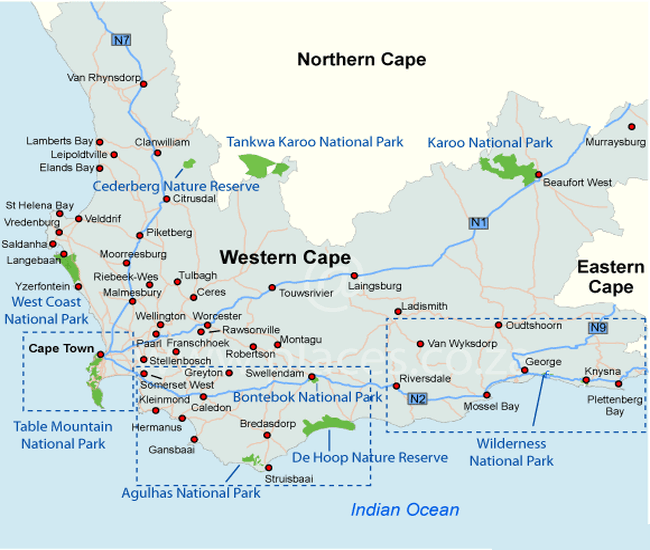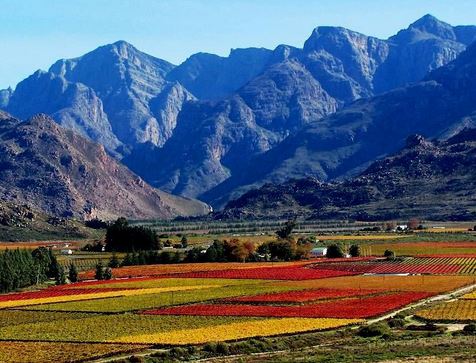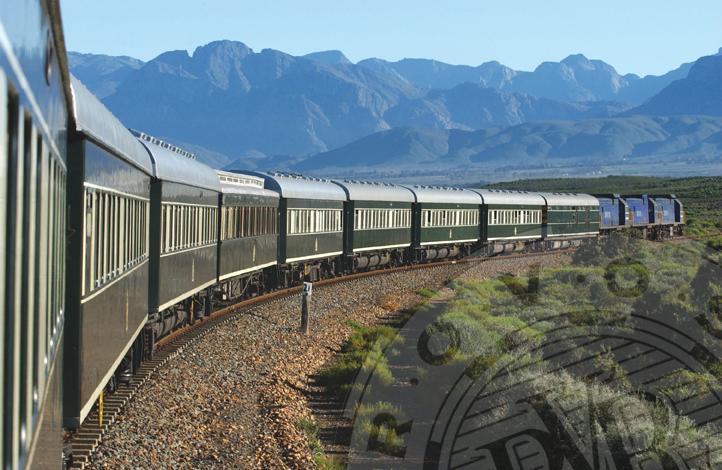Western Cape
The Western Cape is so incredibly beautiful that you can hardly escape the clichés. The beauty of this province is breathtaking, the diversity of the landscape is unparalleled and the range of activities is huge.
Here lies almost 1000 km of unspoilt beach with rugged coasts. Here are fishing villages, extensive vineyards, flower fields, mountain ranges and the temperatures are generally mild and pleasant.
In the national parks you will not encounter the Big Five, but you will find an extensive range of other natural attractions. There are private parks where you can admire the Big Five. This province of South Africa is also called the Fairest Cape, or the most beautiful Cape.
The Western Cape is, due to the overwhelming beauty, the most popular South African area among tourists. However, you can also go to places where you hardly meet anyone and enjoy this beautiful province in silence.
Climate
The Western Cape has dry and sunny summers with daytime temperatures between 15 and 25 degrees. It is often windy and the south-eastern ‘Cape Doctor’ can boom considerably. Winters are generally cool with more rain, but temperatures around 20 degrees are no exception. However, it can also cool down to around 5 degrees and then long trousers and a vest / jacket are indispensable. In the higher mountains it can sometimes even snow. The further north you go, the warmer and drier it gets in the winter months.
The Western Cape is best known for its capital, Cape Town. This impressive metropolis offers an enormous amount of activities and sights and is rightfully called a metropolis, but there are many other towns and villages that are worth a visit.
Cape Town
Cape Town can rightly call itself one of the most beautiful cities in the whole world! The city is beautifully situated on a peninsula around the famous Table Mountain and on the impressive Table Bay. Immediately next to the city you will find a beautiful landscape with mountains, vineyards, palm trees, white beaches, the blue ocean and picturesque fishing villages. Cape Town is also called the ‘Mother City’ because the Dutch settled here in 1652, the first European settlement. This city is bustling with lively art, wild nightlife, great food, local music and beach life.
Stellenbosch
In 1679, Simon van der Stel, governor of the Cape of Good Hope, discovered a beautiful piece of fertile land along the banks of the First River. That same year the first families settled in this new border village “Van der Stel se bosch”. Now four centuries later, this city of Stellenbosch is located in the heart of the Western Cape vineyards.
Mossel Bay
Mossel Bay (Mossel Bay) owes its name to Cornelis de Houtman, a Dutch merchant, who found a lot of mussels here. If you are looking for action, then you must be here. You can go parasailing, abseiling, kayaking and snorkeling here. Seal Island is located in the middle of the bay and can be visited by boat.
Knysna
Knysna is also called the pearl of the Western Cape and the Garden Route. The beach is located on a lagoon with clear blue water and on the other side is surrounded by mountains and deep forests, once large groups of wild elephants lived here .. These forests are the oldest in all of South Africa and even grow to the center. Knysna is known for its oysters that are very popular all over the world because of their unique taste.
Do you want to relax on the beach but also enjoy adventurous activities in the area? Then Knysna is a very suitable location. Here you can mountain biking, kayaking, abseiling, rafting, swimming or diving, all in a beautiful setting. You can hike through the dense forests around Knysna. Besides old trees and exotic plants and flowers, you will also see the most beautiful tropical birds and many species of wildlife.
Sights in the Western Cape
In and around Cape Town
•The Table Mountain
Table Mountain is one of the most famous mountains in the world! This somewhat strange mountain rises 1086 m above the city, was created 450 million years ago and, due to erosion of the softer layers, got its characteristic flat shape. The view from this plateau is truly phenomenal and you shouldn’t miss it. Not only do you overlook Cape Town, but you also see Hely-Hutchinson Lake, the Back Table, False Bay, Cape Point and the Kirschtenbosch National Botanical Gardens.
The most visited attraction of Cape Town is the Victoria and Alfred Waterfront where shopping, hospitality, entertainment and sightseeing go together in the working port of Cape Town.
•Robben Island
Robben Island lies 11 km north of Cape Town in the Atlantic Ocean and has become famous as the place where Nelson Mandela has been imprisoned for 18 years. Already in 1638 the island served as a penal colony of the Dutch. It remained a prison island until 1991. In that year – when Mandela was also released from the Pollsmoor Prison – attention was only drawn to the special nature.
•Cape of Good Hope
The Cape of Good Hope is the famous peninsula to the south of Cape Town where many a ship has sunk due to strong winds and strong currents. The first European to perform around the cape, Bartholomeus Dias, called this point “Cabo Tormentoso”: Storm cape.
Dias was looking for a new sailing route to India and eventually found it around the southern tip of Africa. Later this point became ‘Cabo de Boa Esperança’, Cape of Good Hope. For a long time it was thought that this was the clearest point in all of Africa, but that lies 220 km to the east and is called Cape Agulhas. At Cape Point, at the very bottom of the Cape of Good Hope Nature Reserve, there is the largest lighthouse in the country to show the way to the ships.
The Cape of Good Hope Nature Reserve is a beautiful nature reserve with a large variety of flora and fauna. Here live among other things baboons, seals, red hartebeasts, bontebok, zebras, moose and more than 260 bird species. There are fantastic walks here along deserted beaches and through the beautiful nature. At Buffelsfontein Visitors Center you can get various maps with routes.
•Townships
Township tours will make the traveler realize how the will to survive can overcome any adversity. The overwhelming hospitality, the shops, restaurants, the local beer and the music will amaze and impress you. Don’t go on your own but with a guided tour for an optimal experience.
• Beaches
There is a beach for every mood in Cape Town and the surrounding area:
Clifton for those who want to see and be seen
Camps Bay for the mundane experience
Sandy Bay for the nudists
Muizenberg for a dip in warm water
Kommetjie for water sports
Blouberg beach for surfers
Noordhoek for horse riding enthusiasts
• Kirstenbosch Gardens
The world famous botanical gardens of Kirstenbosch are beautifully situated and have an overwhelming natural beauty. Kirstenbosch is a 528 hectare forest and nature reserve, where only native South African plants and flowers can be admired. The collection consists of more than 9,000 of the total of 22,000 South African plant species. The history of Kirstenbosch begins in 1895, when settler Cecil Rhodes purchases the eastern slopes of Table Mountain to protect the area. After his death in 1902, his land went to the government, who had it turned into a botanical garden in 1913. Kirstenbosch is counted as one of the most beautiful gardens in the world. There is a visitor center with an information desk, a restaurant and a café.
• Nightlife
The center of Cape Town is known to many as the party capital of Africa. In just a few streets there are hundreds of bars, restaurants and clubs waiting to be discovered.
The West Coast
The West Coast was ignored for years by international tourists. They chose Cape Town and the Garden Route over this very interesting region. The beauty of the desert and the beautiful flowers of Namaqualand now seem to have attracted the interest of tourists. The West Coast National Park is wonderful for lovers of the coast, tranquility and space.
The Cape Winelands
The largest and most important wine region of South Africa is located northeast of Cape Town around the towns of Stellenbosch, Franschhoek and Paarl. The landscape is beautiful, like a patchwork of vineyards and orchards full of fruit, and has country houses in Cape Dutch style. Due to the emphatically white history, the landscape looks a bit European. The first white settlers arrived here in the 1960s of the 17th century.
De Garden Route
The Garden Route or Garden Route is located on the south-west coast of South Africa and can rightly call itself one of the country’s highlights. Between Mossel Bay and Plettenberg Bay lies a beautiful coastal area with deep bays, rivers and long sandy beaches that are interspersed with wild cliffs and rocks that seem to sink into the sea. Colorful lagoons extend far inland and rain forests stretch to the coast with sand dunes where a series of salt-bearing lakes lie.
The Klein Karoo
The Karoo covers about one-third of the whole of South Africa and is often classified in the Small and Large Karoo, but there are no precise limits. The small Karoo is mostly located in the Western Cape between the Outenique, Langeberg and Swartberg mountain ranges. Kleine Karoo is a colorful area with high cliffs, deep gorges, rivers with crystal clear water, native flora and majestic mountains. It is very fertile and grows different types of fruit, nuts and tobacco.
You can follow beautiful wine routes along nice places such as Barrydale, Ladismith and Oudtshoorn. Other attractions include the Swartberg Pass, Prince Albert and Gamkasberg Nature Reserve. This last nature reserve turns into a gigantic sea of flowers in the spring, where you can take beautiful walks. Along the way you may spot some baboons, zebras and antelopes.
The Breede River Valley
Some 15 attractive small towns are fortunate in the fertile Breede River Valley. Ceres, named after the Roman goddess of fertility; Tulbagh with 32 historic buildings has the largest concentration of national monuments in South Africa; Montagu with its medicinal ‘hot springs’; Worcester and Robertson are known for their exuberant viticulture. Places of interest in this region include one of the largest brandy distilleries in the world (KWV Brandy Cellar), game gardens, art and curio and museums (eg the Kleinplasie Open Air Museum)
The Overberg
The area of Overberg extends from the Hottentots Holland Mountains to Mossel Bay. In the north lies the Langeberg mountains and in the south the ocean. When the first whites moved from Cape Town to this area, people always referred to the land that was ‘over the mountain’. Only after the construction of the spectacular Sir Lowry’s Pass did the area come to economic development. The path through the Hottentots Holland mountains was steep and only accessible on horseback.
The Overberg has always been in the shadow of the neighbors, Cape Town, the Garden Route and the Wine Route. Overberg is nevertheless a particularly attractive area with a lot of natural beauty. Hermanus is one of the best known places, because here you can watch the South-hijacked whale from July to November from the coast. In Gansbaai you can dive in a cage to the Great White Shark. Other famous places include Bredasdorp, Grabouw and Caledon. The coastal strip contains many elongated beaches with many hotels and resorts. The southernmost point of Africa is located in Cape Agulhas and not in the Cape of Good Hope as previously thought. In the Overberg region there are some nature reserves, such as e.g. Marloth Nature Reserve, De Hoop Nature Reserve and Bontebok National Park.
The Groot Karoo
The Great Karoo covers about one-third of the total land area of South Africa. In size this area is five times Great Britain. There are very few people in South Africa who have a good word for this area. Too hot in the summer and too cold in the winter without enough rain. Life is hard there. 280 million years ago, the Karoo was still a large swamp. The fossil-rich area is a mecca for archaeologists. Victorian settlements date back to more recent times and are well worth a visit.
If you visit the area during a period of long drought, you will not want to stay long. However, after a period of precipitation, the area is completely transformed. Traveling from the Hex River to the north, the precipitation will decrease. In northern locations such as Graaff-Reinet and Colesberg, the rainy period is in the summer, while in the southern part of the Karoo, rainfall falls in the winter period. In the summer months the day temperature exceeds 40 degrees and in the winter it freezes in the north. The temperature fluctuations in the south are less extreme.
Near Beaufort West is the Karoo National Park. This park is best known for its many plain wildlife and bird life. The park covers 60,000 hectares and was opened in September 1979. Some 174 bird species, 38 reptile species, 37 types of geckos and salamanders and 5 different turtles live in the park. In addition to zebras, red hartebeests, antelopes and springboks, there are black rhinos. Other national parks in the Karoo are Tankwa-Karoo National Park and Mountain Zebra National Park near Cradock.




